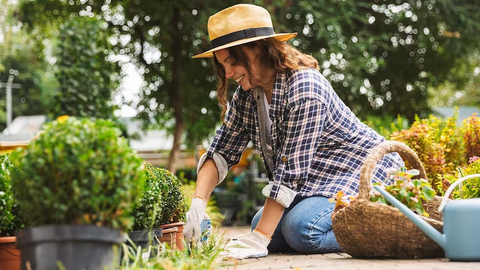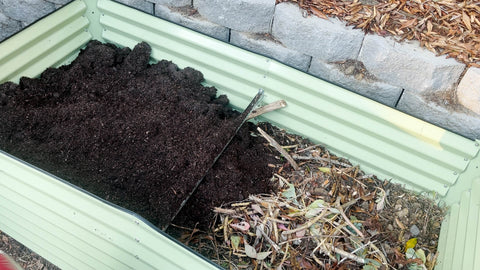The arrival of fall brings with it a symphony of colors as the leaves change, and a crispness to the air that hints at the coming winter. It's also a crucial time for gardeners and homeowners to tend to their landscapes. Fall garden tasks play a vital role in preparing your outdoor space for the changing season and ensuring its beauty and health in the months to come.The following content also has some reference value for raised garden beds.
In this comprehensive guide, we'll explore a variety of fall garden tasks that will help you maintain and enhance your landscape. From lawn care to tree maintenance, we've got you covered.

1. Lawn Care
Aeration
Aerating your lawn is a beneficial fall task. It involves perforating the soil with holes to allow air, water, and nutrients to penetrate the grass roots more effectively. This process helps relieve soil compaction, improves root growth, and enhances overall lawn health.
To aerate your lawn:
- Rent or purchase a lawn aerator.
- Choose a day when the soil is moist but not overly wet.
- Follow the machine's instructions to aerate your lawn evenly.
Overseeding
Overseeding is the practice of sowing grass seed over an existing lawn. It's an excellent way to thicken your turf, fill in bare spots, and improve the overall appearance of your lawn.
To overseed your lawn:
- Mow your existing grass to a short height.
- Remove any debris or thatch.
- Spread grass seed evenly over the lawn using a broadcast spreader.
- Water thoroughly after seeding.
- Keep the soil consistently moist until the new grass is established.
Fertilization
Fertilizing your lawn in the fall is essential for promoting strong root growth and overall grass health. Look for a fall-specific lawn fertilizer with a higher phosphorus content to encourage root development.
Follow the manufacturer's instructions for proper application, and be sure to water the lawn after fertilizing to help nutrients penetrate the soil.
Leaf Management
As leaves begin to fall, it's essential to keep your lawn clear of leaf debris. Leaves left on the grass can block sunlight, trap moisture, and create a habitat for diseases. You can rake and bag the leaves for disposal or use a mulching mower to shred them into fine pieces, which can decompose and enrich the soil.

2. Tree and Shrub Care
Pruning
Fall is an excellent time for pruning trees and shrubs. Removing dead or damaged branches helps improve the overall health and appearance of your plants. Be cautious not to over-prune, as some species prefer pruning in late winter or early spring.
When pruning, use proper techniques and tools to make clean cuts without causing unnecessary damage to the plant. Consult with a local arborist or gardening expert if you're unsure about when or how to prune specific trees or shrubs.
Transplanting
If you have trees or shrubs you'd like to relocate, fall is a suitable time for transplanting. The cooler temperatures and reduced heat stress make it less taxing on the plants. Be sure to water the plants well after transplanting to help them establish their roots in their new location.
Mulching
Mulching around the base of your trees and shrubs can provide several benefits during the fall and winter months. A layer of mulch helps retain soil moisture, regulates soil temperature, and protects plant roots from extreme cold. Make sure to spread mulch evenly and avoid piling it against the trunks of trees or the bases of shrubs, as this can lead to rot and disease.
3. Clean and Store Garden Tools
Before winter arrives, take some time to clean and store your garden tools. Proper maintenance and storage can extend the life of your tools and ensure they're ready for use in the spring.
Here's how to care for your garden tools:
- Clean: Remove dirt, rust, and sap from your tools using a wire brush or steel wool. For stubborn residue, use a putty knife or scraper.
- Sharpen Blades: Use a sharpening tool to sharpen the blades of pruners, shears, and hoes. Sharp tools are more effective and less likely to cause plant damage.
- Oil and Lubricate: Apply a thin layer of oil to metal parts to prevent rust. Lubricate moving parts, such as hinges and joints, with a silicone-based lubricant.
- Store Properly: Hang or store your tools in a dry, cool place. You can also invest in tool racks or storage solutions to keep your tools organized and easily accessible.

4. Gutter Maintenance
Fallen leaves and debris can clog your gutters, leading to water damage to your home's foundation, roof, and siding. Regular gutter maintenance is essential during the fall to prevent these issues.
Here's how to maintain your gutters:
- Clean Gutters: Remove leaves and debris from your gutters using a scoop or a garden trowel. Be sure to wear gloves for safety.
- Check for Damage: Inspect your gutters for any signs of damage, such as rust, leaks, or loose brackets. Repair or replace damaged sections as needed.
- Clear Downspouts: Ensure that downspouts are clear and free of blockages. Use a hose or plumbing snake to dislodge any clogs.
- Install Gutter Guards: Consider installing gutter guards or screens to help prevent debris from entering the gutters in the first place.
5. Exterior Maintenance
Inspect the exterior of your home for any needed repairs before winter weather exacerbates existing issues. Addressing problems now can prevent costly damage down the road.
Here are some exterior maintenance tasks to consider:
- Siding: Check for loose or damaged siding. Repair or replace any sections that are compromised.
- Roof: Inspect your roof for missing or damaged shingles. Address any leaks or issues promptly.
- Windows and Doors: Check for drafts around windows and doors. Seal gaps with weatherstripping or caulking to improve energy efficiency.
- Paint and Stain: If your home has wooden elements, such as a deck or porch, consider reapplying paint or stain to protect the wood from winter moisture.
6. Prepare Outdoor Furniture
If you have outdoor furniture, it's essential to prepare it for the winter months. Proper care and storage can extend the life of your furnishings.
Here's how to prepare outdoor furniture:
- Clean: Wash your furniture to remove dirt and grime. Use a mild detergent and a scrub brush or sponge. Rinse thoroughly.
- Store or Cover: If possible, store your outdoor furniture in a dry, protected area, such as a shed or garage. If storage isn't an option, cover your furniture with waterproof covers designed for outdoor use.
- Protect Cushions: If your furniture has cushions, store them indoors or in a dry, well-ventilated area. Clean and dry them thoroughly before storage to prevent mold and mildew growth.
Conclusion
Fall is a time of transition in the garden and landscape. By tending to these essential fall garden tasks, you'll ensure that your outdoor spaces remain healthy, beautiful, and well-prepared for the changing season. Whether you're caring for your lawn, maintaining trees and shrubs, or getting your garden tools in order, these tasks will help you make the most of this vibrant and transformative time of year.









